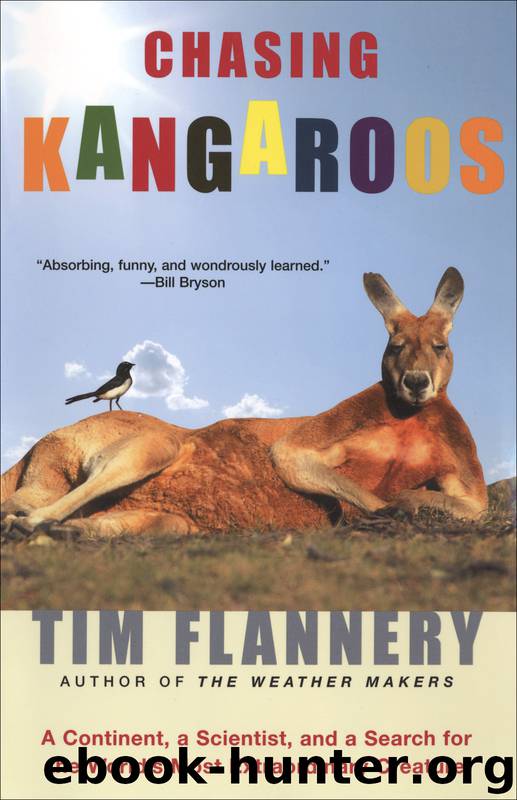Chasing Kangaroos by Tim Flannery

Author:Tim Flannery
Language: eng
Format: epub
Publisher: Grove Atlantic
Published: 2004-03-14T16:00:00+00:00
14 Advancing with Feet or Stomach
Each field season on the Grange Burn revealed a little more of the ancient rainforests that once thrived in Victoria. We learned that the tree-stumps burned off by the basalt flow were celery-top pine, which still grows in Tasmania, yet the fossil teeth we uncovered were like nothing from our southernmost state. Upon breaking open a clod of blueish-grey soil one afternoon, I discovered the distinctive teeth of a type of wallaby known only from the mountains of New Guinea, over 3000 kilometres away to the north. And a few days after that, the tooth of a tree-kangaroo emerged from one of the sieves we used to wash the ancient soil.
Making sense of such finds took some time, but my understanding of the area grew after wandering a few hundred metres downstream to a dome of pink granite-like rock that jutted out from the creek bank. On its upstream side fossil soil lapped its base, while against its downstream face lay sediments formed in an ancient Bass Strait. Here, some eighty kilometres from the modern coast, was the ancient shoreline, complete with oysters, the bones of whales and even the teeth of great white sharks that once swam in its waters. Four and a half million years ago the pink dome of rock must have stood as a bulwark against the force of the Southern Ocean, and in its lee grew our ancient rainforest, perhaps watered by the ancestor of the Grange Burn itself.
It was now 1980, and after four seasons of digging we had turned up only eight isolated teeth belonging to Propleopus which, to add to my frustration, were sent to an expert for study. To me, however, fell the immense pleasure of describing the other kangaroos from the site. There were now hundreds of teeth representing over a dozen species. A close relative of Queensland’s musky rat-kangaroo shared Hamilton’s ancient forests with a larger rat-kangaroo of the bettong type, but the most common creature was very similar to the Tasmanian pademelon (Thy-logale billardierii), which vanished from Victoria a century ago. Hundreds of its teeth had been unearthed, indicating that it was then as dominant in Victoria as its descendant is today in Tasmania.
The genus name for pademelons, Thylogale, means ‘pouched weasel’, which the creatures most emphatically do not resemble. They are instead rather nondescript wallabies, all six species of which inhabit the margins of rainforests and dense scrub from Tasmania to New Guinea. They may well be the ancestral type from which the great kangaroos, striped wallabies, rock-wallabies and tree-kangaroos have sprung, so in some ways they are living fossils. Studying their teeth, I was amazed to see how little the lineage had changed in 4.46 million years. So successful is the Tasmanian pademelon that permits are given to farmers to cull them. While this may seem odd, the creation of pasture by Europeans has benefited it greatly, justifying a sustainable harvest. And besides, its flesh is so far superior to that of the kangaroo that a more basic argument may persuade people to sample it.
Download
This site does not store any files on its server. We only index and link to content provided by other sites. Please contact the content providers to delete copyright contents if any and email us, we'll remove relevant links or contents immediately.
Sapiens: A Brief History of Humankind by Yuval Noah Harari(13046)
The Tidewater Tales by John Barth(12028)
Do No Harm Stories of Life, Death and Brain Surgery by Henry Marsh(6335)
Mastermind: How to Think Like Sherlock Holmes by Maria Konnikova(6233)
The Thirst by Nesbo Jo(5783)
Why We Sleep: Unlocking the Power of Sleep and Dreams by Matthew Walker(5639)
Sapiens by Yuval Noah Harari(4534)
Life 3.0: Being Human in the Age of Artificial Intelligence by Tegmark Max(4502)
The Longevity Diet by Valter Longo(4445)
The Rules Do Not Apply by Ariel Levy(3904)
The Immortal Life of Henrietta Lacks by Rebecca Skloot(3824)
The Body: A Guide for Occupants by Bill Bryson(3797)
Why We Sleep by Matthew Walker(3770)
Animal Frequency by Melissa Alvarez(3752)
Yoga Anatomy by Kaminoff Leslie(3699)
Barron's AP Biology by Goldberg M.S. Deborah T(3630)
The Hacking of the American Mind by Robert H. Lustig(3579)
All Creatures Great and Small by James Herriot(3512)
Yoga Anatomy by Leslie Kaminoff & Amy Matthews(3394)
